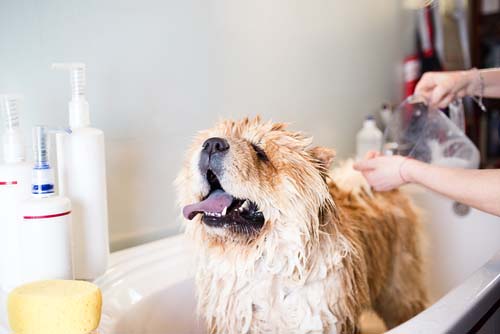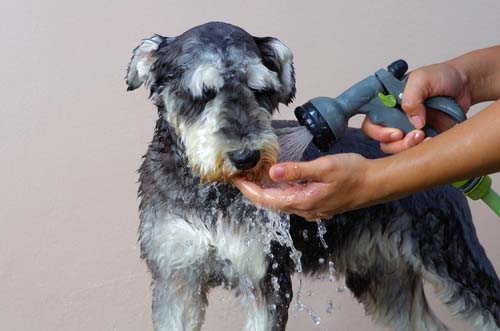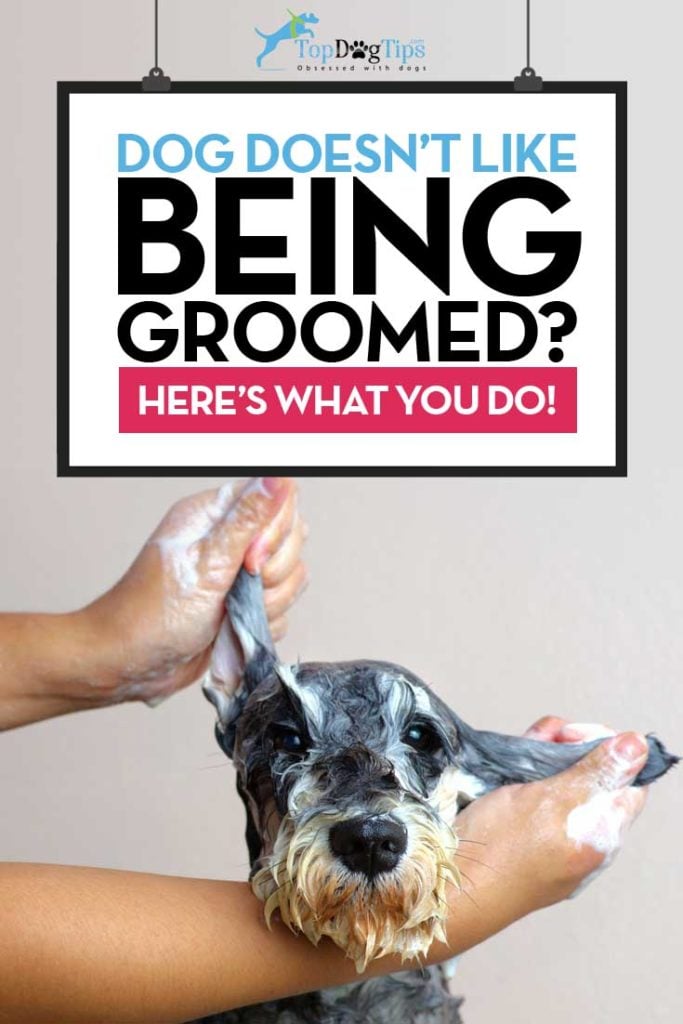Table of Contents
If you learn how to train a dog to enjoy grooming, it will benefit both of you.
The calmer your dog, the easier the process. Your dog won't have to deal with the anxiety brought on by grooming, and you won't have to deal with a stressed-out pet that won't sit still.
While my below tips will work for some pet owners, in certain cases and for dogs with severe anxiety, you'll need to contact a professional trainer or groomer.
If the dog tries to bite you or becomes aggressive during grooming, you don't want to take any chances.
Dog anxiety is common and must be addressed and dealt with seriously.
Grooming an Anxious Dog
For home groomers who are prepared to take matters into their own hands, there's a way to deal with a scared dog safely.
So if your canine is fidgety, pants excessively, or is generally uneasy when you groom them, learning how to train a dog to enjoy grooming won't be too difficult.
With some praise and treats, your pet will soon learn that he has nothing to fear.
One quick tip I'd like to give you right off the bat is this: always keep a positive attitude when working with your dog(s).
This applies not only to dog grooming but also to training dogs or wherever else you're working with pets.
This is because studies have shown that dogs pick up on our emotions and attitude.
Not only that, but dogs also prefer praise over dog treats, meaning your pet would rather your pet and praise them for good behavior than receive something tasty.
It's important to remember this and stay patient, no matter what your pooch does during grooming.
How to Train a Dog to Enjoy Grooming
1. Start Them, Young
It is best to start grooming your dog when he's a young puppy, like all dog training. When dogs get older, they develop bad habits without the proper training.
When you train an older dog, it can be difficult to get him to give up these older bad habits.
If you begin when your dog is still a puppy, he'll learn to enjoy grooming from the very beginning.
Working with a dog that has already learned to fear grooming will be a little more challenging for most pet owners (but not impossible).
That said, the process of keeping a dog calm during grooming is the same either way. It will simply take a lot longer if you're working with an older dog.
2. Allow Them to Get Used to the Area
The key to training a dog to enjoy grooming is getting him used to all the variables and steps of the grooming process.
Put yourself in your dog's shoes (or paws, in this case) for a moment.
Whether you do this in a grooming tub or doggy bath in your bathroom at home, in your basement, in your backyard, or at a grooming salon, grooming always occurs in a separate area.
This (new) separate environment can be scary for the dog. But the more comfortable a dog is in that environment, the less likely he is to be afraid of the process.
So no matter where you will groom your dog, you need to get your pooch used to that environment.
Allow the dog to explore your bathroom or any other grooming area freely.
If it's at a salon, then bring him to the grooming salon multiple times before his first actual appointment.
3. Groom the Dog When He's Tired
It's best to groom a dog when tired, especially if your pup is very energetic.
To get him exhausted before grooming, play a fetch or tug of war, or take him for a long walk beforehand. This will allow your dog to expend all that extra energy that he would normally have to pace, pant, or jump around when you're washing him.
4. Prepare for Tasks and Know What You're Doing
You must know what you're doing when it comes to every one of the grooming tasks.
As mentioned above, dogs can sense our emotions, so if you're nervous, the dog will be nervous too.
You'll need to take things very slowly when learning how to train a dog to enjoy grooming.
Overstimulating a dog usually causes that stress and anxiety in dogs during grooming in the first place.
You're not in a rush (or you shouldn't be), so begin slowly and do each one of these tasks mentioned below one at a time.
Some common pet grooming duties that you'll want to prepare yourself and the dog for include (click on links for more tips for each task):
- Bathing and drying after the bath
- Brushing the dog's coat
- Nail cutting and paw hair trimming
- Teeth cleaning
- Ear cleaning
- Haircut and shaving
Whichever task you choose first, begin by getting your dog used to the environment and start with the dog grooming tools that you will use.
5. Get the Dog Used to the Tools
It is just as important to get them used especially if it's the first time your pooch sees them.
Give your pet plenty of time to notice, observe and smell the grooming equipment you will use.
Reward your dog with a treat and praise for being calm while he's investigating the tools.
Allow your pooch enough time to get comfortable and calm down.
Dogs will be more suspicious of some tools than others. Supplies that make a noise like hair clippers or pet dryers are obviously more likely to cause anxiety in the dog.
So prepare a step-by-step introduction process and keep everything slow.
For example, if you're about to use a dog hair clipper, try doing it this way:
- After the dog has been in the room where you'll groom him for a while and seems to be comfortable here, please take out the hair clipper (do not turn it on) and put it down in front of the dog.
- Let the dog sniff the clipper until he's satisfied.
- Please pick it up, and show the hair clipper again, bringing it closer to the dog. You can even try imitating hair-cutting motions with a turned-off clipper.
- Once the dog seems comfortable around that, reward him with a treat and praise.
- Now, turn the clipper on and let the dog investigate it again; he's likely going to be surprised by the noise.
- Keep the clipper running until your pooch settles down. Once he's calm, again, reward him with a treat and praise.
- Once the clipper's noise becomes the “normal” room tone and your pup seems settled, you can very slowly start using it.
That's the general process that you can use with other grooming tools as well.
6. Tools to Make Grooming Process Easier
With all of that said, you can use several cheap tools as cheats to get your dog to enjoy grooming and stay calm during the process. These will work for bathing, drying, nail and hair cutting, and other tasks.
Here are some of my favorites:
Conclusion
In my video on calming a dog before grooming, when they get used to the environment and grooming tools, you need to let him experience what will happen when used.
Other than the hair clipper example, another one would be using nail clippers.
So when you're getting him used to a pair of such nail clippers, you'll want to show him not only the tool but also handle his paws, toes, and nails – get him used to the sensation.
The goal is to avoid surprising your pet. Give the dog time to get used to every aspect of the grooming process so there will be a few new variables as possible.
If you're using pet towels, then you must continue doing this regularly so that your pooch gets used to this. That way, he won't get overstimulated, and he will stay calm.
Begin with one task at a time and work your way up gradually as your dog begins to enjoy or at least tolerate the previous grooming experience.
Once he's comfortable being washed and dried, you can move on to brushing.
Continue until your dog is comfortable with all the grooming procedures that he will need regularly.
The more fearful your pet is, the longer it will take to learn how to train a dog to enjoy grooming.
If he's an older dog and has been afraid of grooming for years, it's going to be a more difficult process.
You may not be able to help your pet be 100% comfortable with grooming, but you can certainly teach him that there is nothing to fear.
READ NEXT: How To Calm Your Dog Before Grooming
Disclosure: We may earn affiliate commissions at no cost to you from the links on this page. This did not affect our assessment of products. Read more here and find full disclosure here.
















